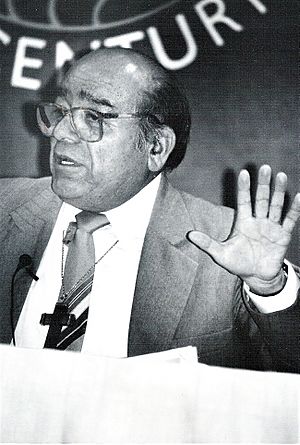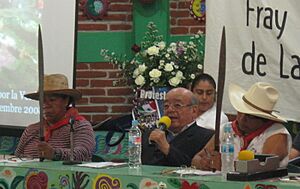Samuel Ruiz facts for kids
Quick facts for kids Samuel Ruiz García |
|
|---|---|
| Bishop of Diocese of San Cristóbal de las Casas, Chiapas | |

Bishop Ruiz in 1996
|
|
| Diocese | San Cristóbal de las Casas |
| Successor | Felipe Arizmendi Esquivel |
| Orders | |
| Ordination | 2 Apr 1949 |
| Consecration | 25 Jan 1960 |
| Personal details | |
| Born | 3 November 1924 Guanajuato, Mexico |
| Died | 24 January 2011 (aged 86) Mexico City, Mexico |
| Denomination | Catholic |
| Alma mater | Gregorian University (PhD) |
Samuel Ruiz García (born November 3, 1924 – died January 24, 2011) was a Mexican Catholic leader. He served as the bishop of the Diocese of San Cristóbal de las Casas, Chiapas, from 1959 to 1999.
Bishop Ruiz is famous for helping to solve problems during a conflict in Mexico. This conflict was between the Zapatista Army of National Liberation (EZLN) and the Mexican government. The government had been in power for a long time. Its rules often made life hard for the indigenous populations (native peoples) in Chiapas.
Ruiz was inspired by a way of thinking called Liberation Theology. This idea became popular in the Catholic Church in Latin America after the 1960s. His diocese helped hundreds of thousands of Maya people in Chiapas. These people were among the poorest and most overlooked communities in Mexico.
Contents
Early Life and Studies
Samuel Ruiz García was born on November 3, 1924, in Guanajuato, Mexico. He was the first of five children. His mother, Guadalupe García, worked as a maid. His father, Maclovio Ruiz Mejía, was a farm worker.
Samuel grew up in a Catholic family during a difficult time called the Cristero War. During this war, the Church faced harsh treatment. Many people were killed by the government, which was against the Catholic Church.
When he was fifteen, Ruiz finished high school and his religious training at a seminary in León, Guanajuato. He then studied at the Jesuit Gregorian University in Rome. There, he focused on Sacred Scripture (the Bible) and earned his doctorate in 1952. In 1949, he became a priest.
Becoming a Bishop
After getting his doctorate in philosophy and theology, Ruiz went back to Guanajuato. He taught at the León seminary. In 1960, he became the bishop of the Diocese of San Cristóbal de las Casas in Chiapas, Mexico. He stayed in this role until he retired in 2000.
The San Cristóbal de las Casas area is mostly made up of highlands in Chiapas. Many poor, native communities live there. They speak different Mayan languages.
When he first became bishop, Ruiz had traditional views about the Church and spreading its message. He believed in older ways of teaching. He even warned against communism in Mexico.
A Journey of Discovery
Not long after arriving, Ruiz traveled across his diocese on a mule. He visited every town and village. During his travels, he saw the extreme poverty and how ignored many communities were. He realized the true struggles of the native people in Chiapas.
This experience changed his views. He later admitted that his earlier actions had not respected their culture. He said, "We only had our own ideas to judge customs. Without knowing it, we were on the side of those who treated the native people unfairly."
Ruiz slowly began to challenge unfair systems. He questioned the government and military. He also questioned people within the church who supported these systems. He encouraged native communities to take control of their lives. He openly said that the poor in Chiapas were victims of unfair systems and violence.
He started to understand and support the Mayan native people. He developed a new way of practicing Catholicism that fit with their culture. He even learned to speak four Mayan languages.
Vatican II and New Ideas
From 1962 to 1965, the Second Vatican Council took place. This important meeting focused on Christians' social responsibility. It also aimed to make the Church more open to new ideas and discussions. Vatican II encouraged translating sermons into local languages. It also wanted the Church to help solve social problems, especially in Central and South America.
For Ruiz, this council helped him think about his past decisions. It inspired him to translate the Bible into native languages. He wanted to make sure the Church's message fit with the local cultures.
Helping the Poor
In 1968, Bishop Ruiz became the president of a group called the Conference of Latin American Bishops (CELAM). This group met in Medellín, Colombia. They agreed that poverty and unfair treatment in Latin America were part of a bigger problem. They saw it as coming from the way powerful countries expanded their influence.
Ruiz and others in the Church started to see how the poor were being used. They realized that workers were often treated unfairly by businesses. Many in the Catholic Church, however, worried that these ideas sounded too much like communism. They felt it might take away from the Church's main mission.
Changes in Chiapas
Under Samuel Ruiz's leadership, the diocese of San Cristóbal de las Casas began to change how it taught the Gospel. Instead of trying to make native people more like Europeans, they started to fit the Gospel into the local culture.
This meant learning the cultures and languages of Chiapas. Services and discussions were held in native languages. Local customs were included in religious teachings. By translating the Bible, the poor people of San Cristóbal began to see how their own struggles were like stories in the Bible, such as the Exodus.
Instead of just focusing on religious matters, church leaders started talking about money and politics. These discussions helped people understand problems in their daily lives. People became more active. They formed small groups called base communities. These groups helped them think together and take action.
The native poor no longer simply accepted low wages or unfair land deals. They used their faith and understanding of the Bible to find solutions to their problems.
In 1989, Bishop Ruiz started the Fray Bartolomé de Las Casas Rights Center. This center worked to stop the growing violence against native people and farmers in his diocese.
Peace Efforts and Mediation
The idea of helping people fight for their human rights seemed like a threat to the government. In some areas, poor people faced even worse treatment. Groups that used the Bible to encourage people to fight for their rights were called Marxists. Governments sometimes ordered military groups to attack civilians who supported these resistance movements.
The native people began to understand that their poverty was linked to a lack of freedom and democracy. They felt this unfair treatment came from the government's policies.
The Zapatista Uprising
On January 1, 1994, a group of native fighters called the Zapatista Army of National Liberation (EZLN) took over government offices in San Cristóbal de las Casas. This happened on the same day a trade agreement called NAFTA started. The Zapatistas were upset about how native people were being treated. Their name was inspired by Emiliano Zapata, a hero from the Mexican Revolution who fought for fairness.
The Mexican government was very angry. They blamed Bishop Ruiz's work for the Zapatista Uprising. The government had been in power for almost 70 years. They tried to stop the uprising with military force.
Ruiz as Mediator
Bishop Ruiz later explained his role. He said, "It was clear that the diocese could not ignore the situation." He saw his job as helping both sides talk to each other. He wanted to build trust between the Zapatistas and the government.
The Zapatista Army gained attention from Mexico and other countries. Ruiz was chosen to be the mediator (someone who helps solve disagreements). During talks, the Zapatistas asked for more than just legal recognition. They wanted big changes to the government and unfair systems.
Challenges to Peace
The government tried to capture the Zapatista leader, Subcomandante Marcos. This made the situation very tense. There were arrests of people thought to be involved with the Zapatistas. Even Bishop Samuel Ruiz was briefly accused of helping to hide Zapatista activities. However, his work was well-known, and the government had tried to hide it for years.
Many people, including government officials who wanted peace, worked hard to avoid a full military conflict. They believed that a peaceful solution was possible. This effort helped prevent more violence.
San Andrés Accords
More and more people in Mexico and around the world supported the Zapatistas. In 1996, the San Andrés Accords were signed by the EZLN and the government. This agreement promised to respect the native people of Chiapas. It gave them the right to help plan their own development. It also gave them control over their local government and legal matters. They were granted self-government.
However, the Zapatistas accepted these conditions, but President Ernesto Zedillo refused to put them into action. Still, the efforts to find a peaceful solution saved many lives in Mexico.
Retirement and Legacy
In 1998, Bishop Samuel Ruiz stepped down as the peace mediator. He said the government was only pretending to work towards peace. He continued to support Chiapas and fight for the human rights of native people until he died in 2011. After he retired, Bishop Felipe Arizmendi Esquivel, who also supported social progress, took his place.
Death
Samuel Ruiz García passed away on January 24, 2011, at the age of 86. He died in Mexico City due to breathing problems and other health issues. During a special church service in Mexico City, other bishops honored him. They said that while some people disagreed with his actions, for the poor and those who worked with him, "Don Samuel was a bright light."
Don Samuel, also known as jTatic Samuel, was buried in the cathedral in San Cristóbal de las Casas. His life and work were celebrated with much love and joy.
Awards
Samuel Ruiz received several important awards for his work:
- In 1996, he received the Pacem in Terris Peace and Freedom Award. This was for his fight against unfairness and violence against the poor in his diocese.
- In 1997, he received the Martin Ennals Award for Human Rights Defenders.
- In 2000, UNESCO gave him the Simon Bolivar International Prize. This was for defending the native peoples of Chiapas. It also recognized his role as a mediator between the government and the Zapatista Army of National Liberation. The award honored his dedication to human rights and fairness for people in Latin America.
- He was also nominated for the Nobel Peace Prize in 1994, 1995, and 1996. Important figures like Rigoberta Menchú and Adolfo Pérez Esquivel nominated him.
Images for kids
See also
 In Spanish: Samuel Ruiz García para niños
In Spanish: Samuel Ruiz García para niños



